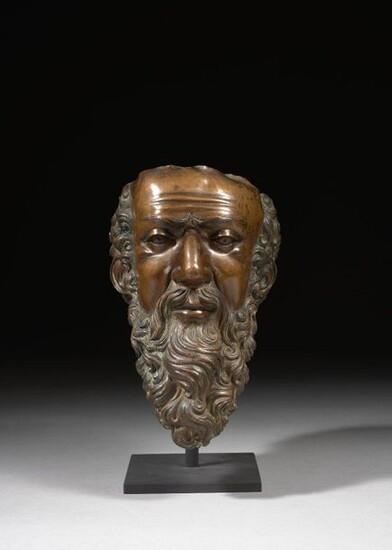CHEF-RELIQUARY, ROME OR FLORENCE Early 16th century
CHEF-RELIQUARY, ROME OR FLORENCE Early 16th century
In embossed and chiselled copper; traces of gilding, mounted on a black metal stand
H. : 24 cm (9 ½ in.)
W.: 12.5 cm (13 in.)
An embossed and chiseled copper chief reliquary, Rome or Florence, early 16th century
The term Head-reliquary (from the Latin "caput" the head) designates a type of reliquary qualified as topical, i.e. following the shape of the object it contains, also called morphological reliquary because it has a part of the human body.
Head reliquaries, intended to preserve a skull or a part of it, are generally in the form of a goldsmith's head made of embossed and chased metal, gold, silver or gold-plated copper, sometimes presented with the bust and most often articulated at the level of the skull cap.
by a hinge. While some are reinforced with a wooden core, others, like here, are entirely metal.
Appearing as early as the ninth century, the Chief Reliquaries are among the earliest anthropomorphic sculptures in the Christian West. After reaching their peak of production in the 14th and 15th centuries, the number of Chief reliquaries diminished and evolved towards gilded wooden reliquary busts in Baroque art until the 19th century.
The head shown here has a face with accentuated features, a wrinkled forehead, protruding eyebrows hugging the eyes with eyelids and pupils chiseled with fine serrations. The face is framed by a long beard with sinuous curls ending in hooks. The top of the skull, which is missing, must have been a hinged lid forming the skull cap. The missing base could have been made up of a set of shoulders forming the pedestal. The marked length of the beard may suggest the representation of a holy ascetic, hermit or anchorite.
Brilliant work of sculpture as much as of goldsmith's art, this head may have originated in the Italy of the first Renaissance, around the beginning of the 16th century, in one of the Roman or Florentine workshops that attracted goldsmiths from all over Europe in a period of intense creation where several disciplines were practiced by the same artists, such as architecture, sculpture, goldsmith's art or painting, drawing and engraving.
Among the chief reliquaries and comparable busts preserved in Italy are the following: the reliquary bust of Saint Justin by Nicola di Guardiagrele around 1455, once kept in the cathedral of Chieti; the Chief reliquary of Saint Pamphile by Giovanni di Marino di Cicco, around 1460 in the cathedral of Sulmone (Abruzzo); or the bust of Saint Andrew by the Florentine Simone di Giovanni Ghini, c. 1463, in the Diocesan Museum of Pienza; and the bust of Saint Silvestre by Antonio di Salvi Salvucci, c. 1497 for the Carthusian monastery of Vedana, today in the Diocesan Museum of Feltre. Automatically translated by DeepL. To see the original version, click here.
View it on
Estimate
Time, Location
Auction House
CHEF-RELIQUARY, ROME OR FLORENCE Early 16th century
In embossed and chiselled copper; traces of gilding, mounted on a black metal stand
H. : 24 cm (9 ½ in.)
W.: 12.5 cm (13 in.)
An embossed and chiseled copper chief reliquary, Rome or Florence, early 16th century
The term Head-reliquary (from the Latin "caput" the head) designates a type of reliquary qualified as topical, i.e. following the shape of the object it contains, also called morphological reliquary because it has a part of the human body.
Head reliquaries, intended to preserve a skull or a part of it, are generally in the form of a goldsmith's head made of embossed and chased metal, gold, silver or gold-plated copper, sometimes presented with the bust and most often articulated at the level of the skull cap.
by a hinge. While some are reinforced with a wooden core, others, like here, are entirely metal.
Appearing as early as the ninth century, the Chief Reliquaries are among the earliest anthropomorphic sculptures in the Christian West. After reaching their peak of production in the 14th and 15th centuries, the number of Chief reliquaries diminished and evolved towards gilded wooden reliquary busts in Baroque art until the 19th century.
The head shown here has a face with accentuated features, a wrinkled forehead, protruding eyebrows hugging the eyes with eyelids and pupils chiseled with fine serrations. The face is framed by a long beard with sinuous curls ending in hooks. The top of the skull, which is missing, must have been a hinged lid forming the skull cap. The missing base could have been made up of a set of shoulders forming the pedestal. The marked length of the beard may suggest the representation of a holy ascetic, hermit or anchorite.
Brilliant work of sculpture as much as of goldsmith's art, this head may have originated in the Italy of the first Renaissance, around the beginning of the 16th century, in one of the Roman or Florentine workshops that attracted goldsmiths from all over Europe in a period of intense creation where several disciplines were practiced by the same artists, such as architecture, sculpture, goldsmith's art or painting, drawing and engraving.
Among the chief reliquaries and comparable busts preserved in Italy are the following: the reliquary bust of Saint Justin by Nicola di Guardiagrele around 1455, once kept in the cathedral of Chieti; the Chief reliquary of Saint Pamphile by Giovanni di Marino di Cicco, around 1460 in the cathedral of Sulmone (Abruzzo); or the bust of Saint Andrew by the Florentine Simone di Giovanni Ghini, c. 1463, in the Diocesan Museum of Pienza; and the bust of Saint Silvestre by Antonio di Salvi Salvucci, c. 1497 for the Carthusian monastery of Vedana, today in the Diocesan Museum of Feltre. Automatically translated by DeepL. To see the original version, click here.



